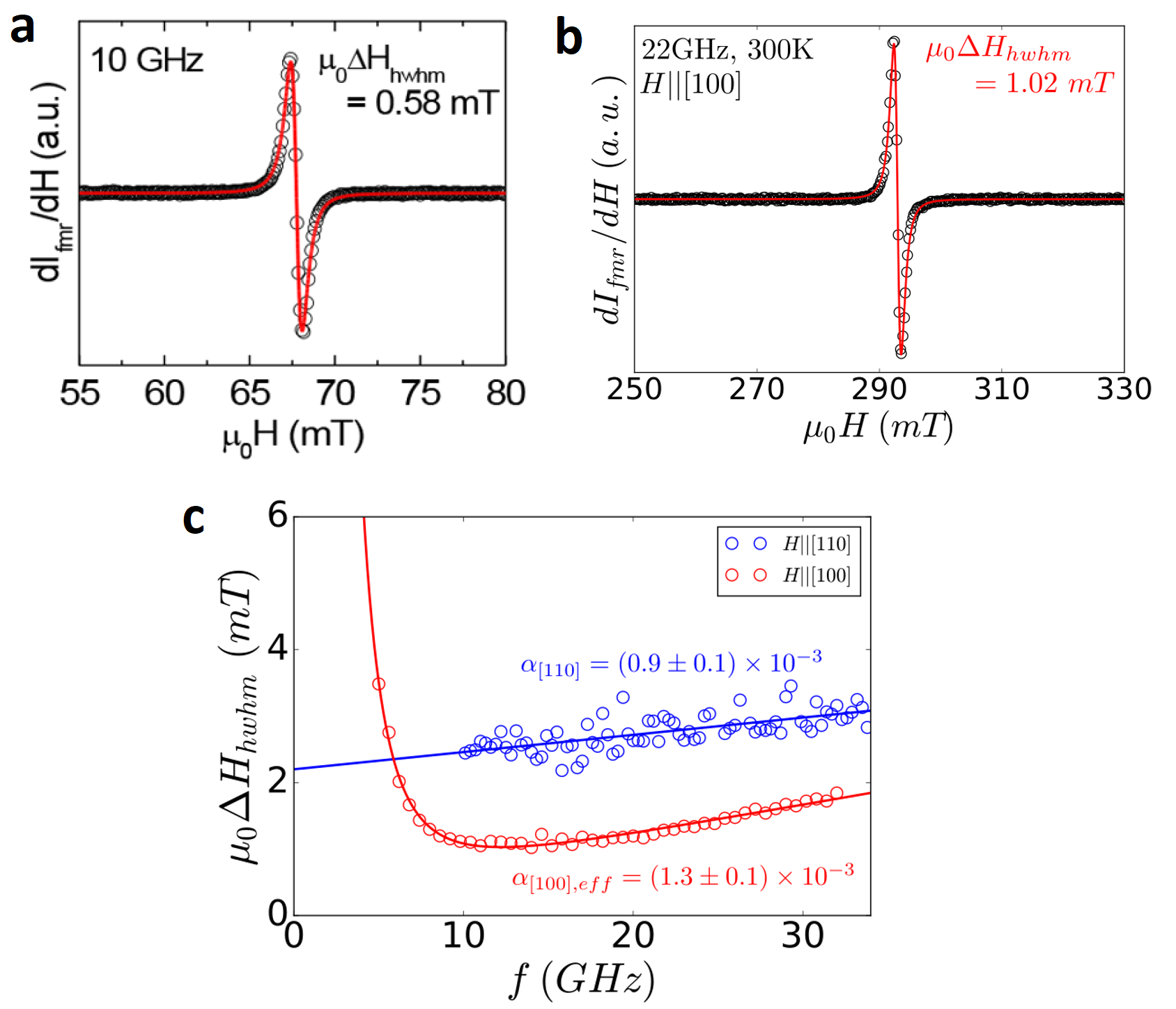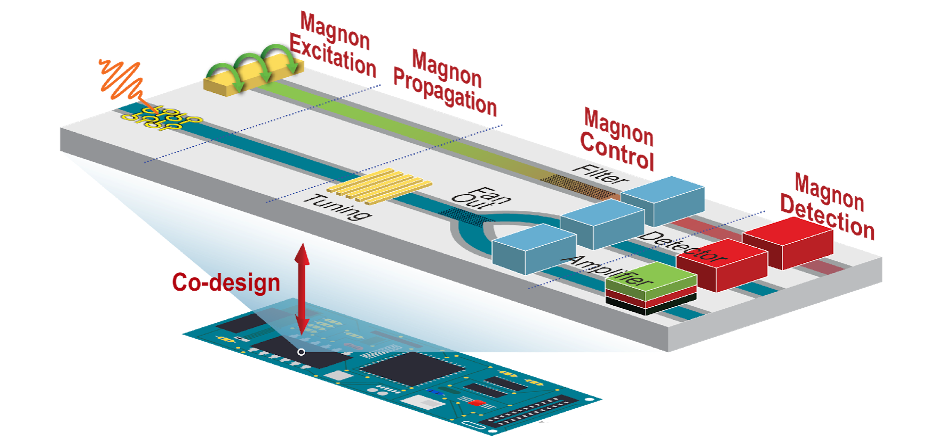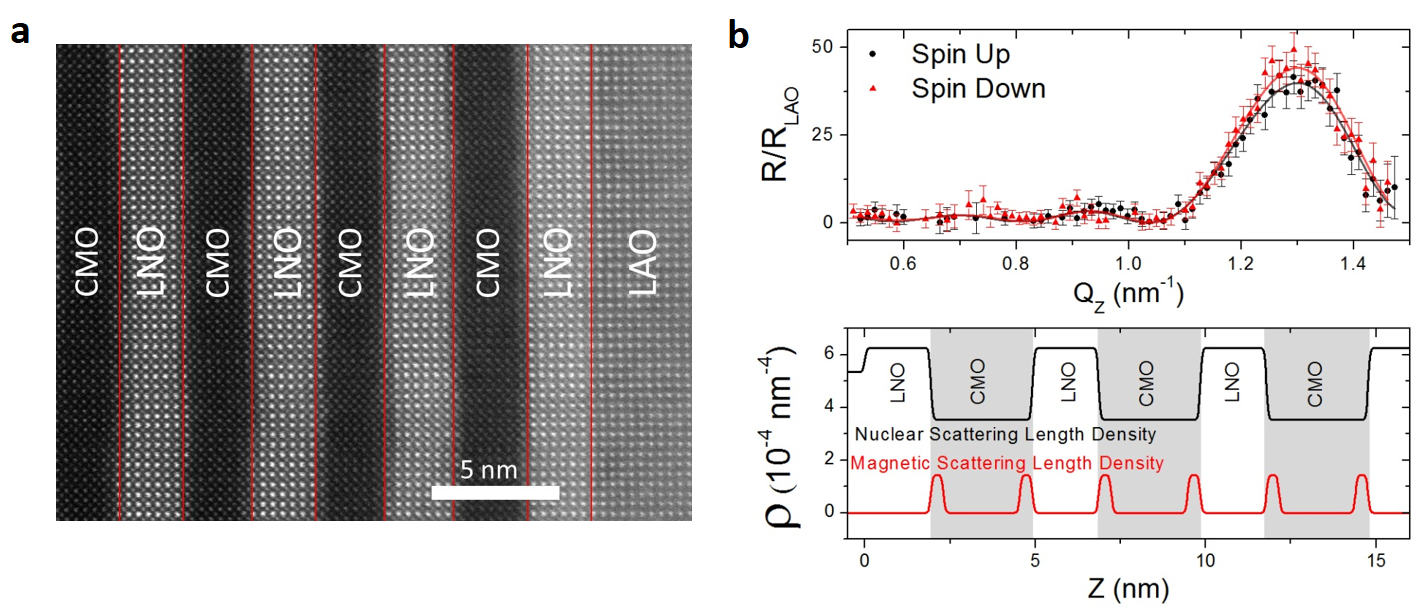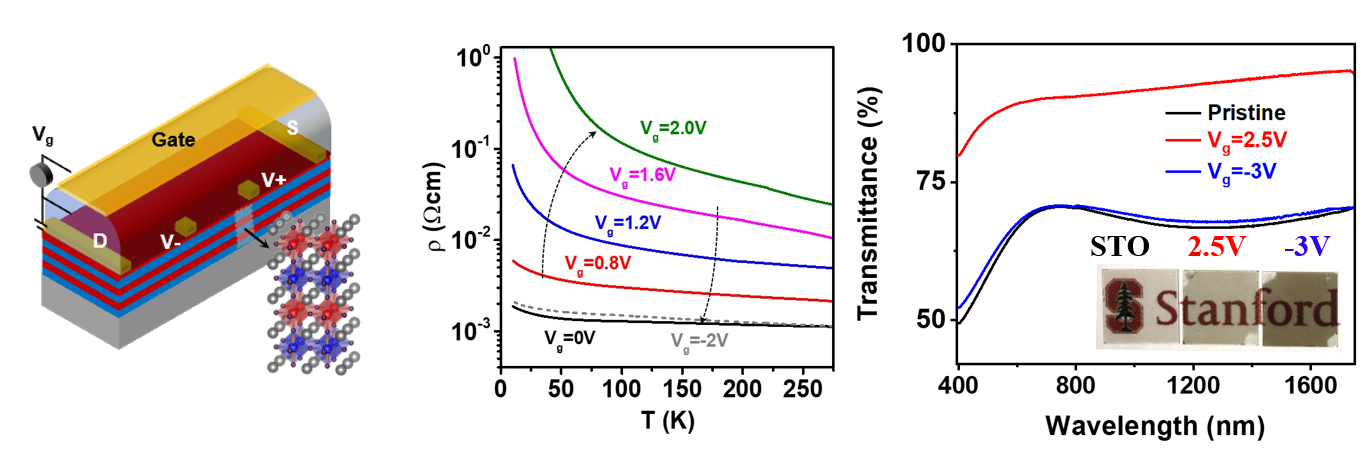Research Areas
Our group focuses on the study of novel ground states and functional properties in condensed matter systems synthesized via atomically precise thin film deposition techniques.
These model systems often provide for ground states and functional properties not observable in the bulk. Our recent emphasis has been on highly correlated electronic systems, especially new spintronic materials that address fundamental questions that still exist in magnetism. Projects have also included the development of spin polarized devices, and more recently, spin current generation based on complex oxide thin films. We are also developing low dimensional metallic systems at oxide interfaces. Nanofabrication is used to study functional properties at the nano-scale as well as to fabricate new classes of nano-scale devices.
Research projects include:
- Spintronics and Spin Current Generation
- Magnon-based Devices
- Emergent Magnetic Phenomena at Interfaces
- Low Dimensional Transport and Magnetism
Spintronics and Spin Current Generation in Complex Oxide Systems
Materials with spin functionality in the bulk and at interfaces have enormous potential in transforming future energy relevant technologies. The manipulation of electrons via their charge has dominated electron transport but manipulation of electrons via their spin has been recognized as a potentially more energy efficient alternative. To date, the manipulation of spin has often involved the flow of spin-polarized charge current where there is flow of both net charge and spin, thereby having the same power dissipation issues as charge current. Spin transport via the generation and control of angular momentum flow in spin currents offer low power information processing. Spin currents may take the form of spin waves (or magnons) in insulators and metals or diffused spin polarized electrons in metals. The ultimate goal is to manipulate spin without moving charge, minimizing dissipation and leading to an increase in energy efficiency. So ferromagnetic insulators are the ideal candidate materials as they minimize dissipation due to conduction electrons.
We have developed low damping ferromagnetic insulating films based on spinel structure ferrites (Ni,Zn)(Al,Fe)2O4, Li0.5Fe2.5O4 and Mg(Al,Fe)2O4. We have incorporated these low damping ferrite films into heterostructures to demonstrate efficient spin current generation, spin torque ferromagnetic resonance and spin torque switching. We have demonstrated ultra-low damping in nanometer thick films, making them switchable via spin torques.

(a) and (b) show sample FMR spectra of MAFO and LFO respectively. (c) shows in-plane FMR linewidth as a function of frequency for a 3 nm LFO film with damping on the order of 0.001.
Relevant Publications
- S. Emori, B. A. Gray, H.-M. Jeon, J. Peoples, M. Schmitt, K. Mahalingam, M. Hill, M. E. McConney, M. T. Gray, U. S. Alaan, A. C. Bornstein, P. Shafer, A. T. N'Diaye, E. Arenholz, G. Haugstad, K.-Y. Meng, F. Yang, D. Li, S. Mahat, D. G. Cahill, P. Dhagat, A. Jander, N. X. Sun, Y. Suzuki, B. M. Howe, “Coexistence of Low Damping and Strong Magnetoelastic Coupling in Epitaxial Spinel Ferrite Thin Films,” Advanced Materials 29 1701130 (2017).
- Satoru Emori, Di Yi, Sam Crossley, Jacob J. Wisser, Purnima P. Balakrishnan, Behrouz Khodadadi, Padraic Shafer, Christoph Klewe, Alpha T. N’Diaye, Brittany T. Urwin, Krishnamurthy Mahalingam, Brandon M. Howe, Harold Y. Hwang, Elke Arenholz, and Yuri Suzuki, “Ultralow Damping in Nanometer-Thick Epitaxial Spinel Ferrite Thin Films,” Nano Letters 18(7) 4273 (2018).
- L.J. Riddiford, J.J. Wisser, S. Emori, P. Li, D. Roy, E. Cogulu, O. van ‘t Erve, S.X. Wang, B.T. Jonker, A.D. Kent, and Y. Suzuki, “Efficient Spin Current Generation in Low-Damping Mg(Al,Fe)2O4 Thin Films,” Applied Physics Letters 12, 122401 (2019).
- Jacob J. Wisser, Satoru Emori, Lauren Riddiford, Aaron Altman, Peng Li, Krishnamurthy Mahalingam, Brittany T. Urwin, Brandom M. Howe, Michael R. Page, Alexander J. Grutter, Brian J. Kirby, and Yuri Suzuki, “Ultrathin interfacial layer with suppressed room temperature magnetization in magnesium aluminum ferrite thin films,” Applied Physics Letters 115, 132404 (2019).
- Jacob J. Wisser, Lauren J. Riddiford, Aaron Altman, Peng Li, Satoru Emori, Padraic Shafer, Christoph Klewe, Alpha T. N'Diaye, Elke Arenholz, and Yuri Suzuki, “The role of iron in magnetic damping of Mg(Al,Fe)2O4 spinel ferrite thin films,” Applied Physics Letters 116 142406 (2020).
- Xin Yu Zheng, Lauren J. Riddiford, Jacob J. Wisser, Satoru Emori, and Yuri Suzuki, “Ultra-low magnetic damping in epitaxial Li0.5Fe2.5O4 thin films,” Applied Physics Letters 117 092407 (2020).
Magnon-based Devices
We are exploring the viability of magnon-based interconnects through the study of magnon excitation, transmission, detection and control. To tackle the multi-disciplinary scientific challenges of understanding magnon behavior and making useful interconnects, we have assembled an Energy Frontier Research Center (EFRC) based at SLAC National Laboratory with partners at Cornell, Morgan State, Northwestern, Ohio State, UC Irvine, University of Iowa and UT Austin. Our EFRC, called the Center for Energy Efficient Magnonics, addresses the critical challenges in magnon interconnects in advanced materials, efficient magnon detection and functionality. More information can be found here.

Magnon interconnects will be realized by addressing fundamental questions concerning magnon excitation, propagation, control and detection.
Emergent Magnetic Phenomena Through Complex Oxide Heteroepitaxy
Controlling collective phenomena and emergent properties at interfaces often leads to new ground states not attainable in their bulk constituents. By designing and perfecting atomic level synthesis of materials with rich phase diagrams in the bulk, we explore new classes of complex oxide interface systems. These systems provide for quasi-two-dimensional model systems with spin functionality in which we can address fundamental questions about the nature of magnetism at surfaces and interfaces but also provide promising new materials for a more energy efficient spin based electronics.
Examples of such interface systems include superlattices of the antiferromagnetic insulator CaMnO3 and paramagnetic metal CaRuO3 or LaNiO3. The ferromagnetic behavior emerges in one unit cell at the interface and can be understood in terms of a double exchange interaction among interfacial Mn ions mediated by itinerant electrons in the paramagnetic metal. Interestingly LaNiO3 exhibits a thickness dependent metal insulator transition and the emergence of strong ferromagnetism is coincident with the metallic conduction in LaNiO3.
We have demonstrated emergent perpendicular magnetism at the interfaces of manganite/iridate superlattices. The perpendicular magnetism appears for heavily Sr doped LaMnO3 and SrIrO3 at a magnetic transition that is coupled with metal-insulator and optical transitions. These reversible and coupled phase transformations can be correlated to structural transformations brought on by electrolytic gating which can lead to the transfer of oxygen and hydrogen ions. These results suggest that these digital superlattices provide a new class of materials for electrolytic control of structure and function.

(a) High resolution STEM Z contrast image of a 6 unit cell LaNiO 3/8 unit cell CaMnO3 superlattice. (b) [Above] Fitted polarized neutron reflectivity with standard error at 800 mT and 15 K at the first order superlattice reflection of a 5 unit cell LaNiO3/8 unit cell CaMnO3 superlattice. [Below] We show below the model used to obtain this fit, in which we assume one unit cell of magnetized CaMnO3.

Electric control of resistivity of a SrMnO3/SrIrO3 superlattice and corresponding electrochromic effect.
Electric control of magnetic properties shows that perpendicular magnetism can be completely suppressed with enough electric gate voltage.
Relevant Publications
- C. He, A.J. Grutter, M. Gu, N.D. Browning, Y. Takamura, B.J. Kirby, J.A. Borchers, J.W. Kim, M.R. Fitzsimmons, X. Zhai, V.V. Mehta, F.J. Wong, and Y. Suzuki, “Interfacial ferromagnetism and exchange bias in CaRuO3/CaMnO3 superlattices,” Physical Review Letters 109 197202 (2012).
- A. J. Grutter, B. J. Kirby, M. T. Gray, C. L. Flint, U. S. Alaan, Y. Suzuki, and J. A. Borchers, “Electric Field Control of Interfacial Ferromagnetism in CaMnO3/CaRuO3 Heterostructures,” Physical Review Letters 115 047601 (2015).
- A. J. Grutter, A. Vailionis. J.A. Borchers, B. J. Kirby, C. L. Flint, C. He, E. Arenholz, and Y. Suzuki, “Interfacial Symmetry Control of Emergent Ferromagnetism,” Nano Letters 2016, 16 (9), pp 5647-5651 (published on the web July 29, 2016).
- C. L. Flint, H. Jang, J.-S. Lee, A. T. N'Diaye, P. Shafer, E. Arenholz, and Y. Suzuki, “Role of polar compensation in interfacial ferromagnetism of LaNiO3/CaMnO3 superlattices,” Physical Review Materials 1 024404 (2017).
- C. L. Flint, D. Yi, E. Karapetrova, A. T. N'Diaye, P. Shafer, E. Arenholz, and Y. Suzuki, “Enhanced interfacial ferromagnetism and exchange bias in (111)-oriented LaNiO3/CaMnO3 superlattices,” Phys. Rev. Materials 3, 064401 (2019).
- Di Yi, Yujia Wang, Olaf M. J. van‘t Erve, Liubin Xu, Hongtan Yuan, Michael J. Veit, Purnima P. Balakrishnan, Yongseong Choi, Alpha T. N‘Diaye, Padraic Shafer, Elke Arenholz, Alexander Grutter, Haixuan Xu, Pu Yu, Berend T. Jonker, and Yuri Suzuki, “Emergent electric field control of phase transformation in oxide superlattices,” Nature Communications 11 902 (2020).
Low Dimensional Transport and Magnetism in Quasi-two Dimensional Electron Gases Formed at Oxide Interfaces
Electronic reconstruction at a Mott insulator/ band insulator interface has been predicted to exhibit a wide range of emergent electronic and magnetic behavior. A particularly interesting example system is the LaTiO3/SrTiO3 interface where electronic reconstruction gives rise to low dimensional metallic behavior accompanied by giant Rashba spin-orbit coupling. We studied ultrathin films of LaTiO3 on SrTiO3 substrates where interface reconstruction dominates the transport behavior. We found evidence for giant Rashba spin splitting in two sets of Shubnikov-de Haas oscillations associated with an inner and outer Fermi surface, Berry phase of π, substantial anisotropic magnetoresistance and a weak anti-localization correction to the magnetoconductivity. Together these results indicate a large Rashba coupling coefficient which is an order of magnitude larger than other complex oxide interfaces. Such a large Rashba coupling suggests that such a Mott/band insulator interface may be an excellent candidate for spin current-based electronics.

Shubnikov de Haas oscillations at the LaTiO3/SrTiO3 interface are observed at low and high fields corresponding to high mobility carriers at two Fermi surfaces. Combined with the Berry’s phase of π deduced from the Landau fan diagram of the Shubnikov de Haas oscillations, we deduce a giant Rashba spin splitting at this interface.
Relevant Publications
- M. J. Veit, R. Arras, B. J. Ramshaw, R. Pentcheva and Y. Suzuki, “Nonzero Berry phase in quantum oscillations from giant Rashba-type spin splitting in LaTiO3/SrTiO3 heterostructures,” Nature Communications 9 1458 (2018).

